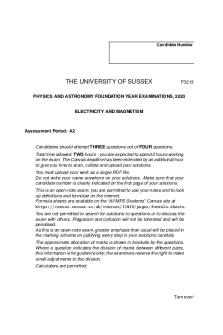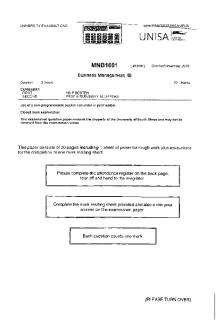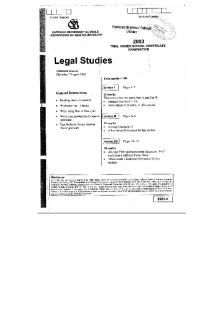2020 F3213 - Past paper PDF

| Title | 2020 F3213 - Past paper |
|---|---|
| Course | Electricity and Magnetism |
| Institution | University of Sussex |
| Pages | 5 |
| File Size | 122.6 KB |
| File Type | |
| Total Downloads | 21 |
| Total Views | 144 |
Summary
Past paper...
Description
Candidate Number
THE UNIVERSITY OF SUSSEX
F3213
PHYSICS AND ASTRONOMY FOUNDATION YEAR EXAMINATIONS, 2020 ELECTRICITY AND MAGNETISM
Assessment Period: A2
Candidates should attempt THREE questions out of FOUR questions. Total time allowed: TWO hours - you are expected to spend 2 hours working on the exam. The Canvas deadline has been extended by an additional hour to give you time to scan, collate and upload your solutions. You must upload your work as a single PDF file. Do not write your name anywhere on your solutions. Make sure that your candidate number is clearly indicated on the first page of your solutions. This is an open-note exam: you are permitted to use your notes and to look up definitions and formulae on the internet. Formula sheets are available on the “All MPS Students” Canvas site at https://canvas.sussex.ac.uk/courses/15016/pages/formula-sheets. You are not permitted to search for solutions to questions or to discuss the exam with others. Plagiarism and collusion will not be tolerated and will be penalised. As this is an open-note exam, greater emphasis than usual will be placed in the marking scheme on justifying every step in your solutions carefully. The approximate allocation of marks is shown in brackets by the questions. Where a question indicates the division of marks between different parts, this information is for guidance only; the examiners reserve the right to make small adjustments to the division. Calculators are permitted.
Turn over/
F3213
ELECTRICITY AND MAGNETISM
All numerical answers should contain at least the first two significant digits 1.
(i) Consider an infinitely long solenoid with n turns per unit length carrying a current I. Derive the expression for the self inductance per unit length dL/dℓ of an infinitely long solenoid whose cross section is a circle of radius a, as a function of a and of the number of turns per unit length n. Then, compute the numerical value of dL/dℓ for a = 0.5 cm and n = 3000 m−1 . [6 marks] (ii) Two identical small insulating balls are suspended by separate threads, each of length L = 0.25 m, that are attached to a common point on the ceiling. Each ball has a mass m = 8 × 10−4 kg. Initially the balls are uncharged and hang straight down. They are then given identical positive charges q and, as a result, spread apart with an angle θ = 36o between the threads, as shown in the figure below.
(a) Draw a free-body diagram displaying all the forces on either of the two balls. [3 marks] (b) Compute the value of total charge q deposited on each ball. [7 marks] (c) Compute the electric potential in the midpoint between the balls. [4 marks]
2
ELECTRICITY AND MAGNETISM 2.
F3213
(i) Given the logic gate circuit in the figure:
A B
X
(a) convert it into a Boolean expression; [4 marks] (b) simplify the obtained Boolean expression; [4 marks] (c) draw the logic gate circuit corresponding to the simplified expression. What elementary gate does it correspond to? [2 marks] (ii) An electric motor is designed to operate in alternating current on a rms voltage V0 = 220 V and draws a rms current I0 = 12 A when it first starts up. At its normal operating speed, the motor draws a rms current I1 = 2 A. (a) Compute the resistance R of the armature coil. [3 marks] (b) Explain why the current drawn by the motor at normal speed is less than that drawn when the motor starts. [3 marks] (c) Compute the rms back emf E developed at normal speed. [4 marks]
3
Turn over/
F3213 3.
ELECTRICITY AND MAGNETISM (i) State Kirchhoff’s rules, explaining which physical laws are implemented through them. [4 marks] (ii) A long, coaxial cable, shown in cross-section in the drawing, is made using two conductors that share a common central axis, labelled C. The current in the inner conductor is I1 = 1.5 A directed out of the page and that in the outer conductor is I2 = 3.0 A directed into the page. Point A and point B are both outside the inner conductor, and respectively inside and outside the outer conductor, as shown in the drawing. The distance from point C to point A is rA = 1.2 mm; and the distance from C to B is r B = 2.4 mm. (a) Show that the magnetic field at point A and point B in the figure is the same as that of an infinitely long wire at C, carrying currents IA and IB respectively. Determine IA and IB , and then draw the magnetic field lines at points A and B. [9 marks] (b) An electron reaches point A with a velocity v = 3.6 × 106 m/s, having the same direction as current I1 . Compute the magnitude and direction of the magnetic force on the electron. [4 marks] (c) Compute the magnitude and direction of the magnetic force on an electron that reaches point B with the same velocity (both in direction and magnitude) as the electron of part (b). [3 marks]
4
ELECTRICITY AND MAGNETISM 4.
F3213
(i) State Coulomb’s law, defining clearly all quantities involved and the physical assumptions made. [5 marks] (ii) Consider the circuit in the diagram below, where two ideal dc batteries deliver a terminal voltage of V1 = 2 V and V2 = 10 V respectively. The magnitude of the resistances is R1 = R2 = 2 Ω and R3 = 3 Ω.
R3 R2
R1 V1 + −
V2 + −
(a) Calculate the magnitude and direction of the current through resistor R1 . [7 marks] (b) What is the power of each battery, and is energy used by or supplied by each battery? [8 marks]
End of Paper
5...
Similar Free PDFs

2020 F3213 - Past paper
- 5 Pages

616963 past paper tsa 2020 section 1
- 36 Pages

HSB January 2020 p2 - cxc past paper
- 24 Pages

Uob past paper
- 4 Pages

Legal Studies Past paper
- 18 Pages

STAT270 - past exam paper
- 24 Pages

Macroeconomics Past Paper
- 12 Pages

Past exam Paper 2018
- 23 Pages

Trial past exam paper
- 7 Pages

ANAT2004 2019 past paper
- 16 Pages

MA103 Past Paper Exam
- 5 Pages

2010 exam - past paper
- 25 Pages

KIT710-2015 - past exam paper
- 6 Pages
Popular Institutions
- Tinajero National High School - Annex
- Politeknik Caltex Riau
- Yokohama City University
- SGT University
- University of Al-Qadisiyah
- Divine Word College of Vigan
- Techniek College Rotterdam
- Universidade de Santiago
- Universiti Teknologi MARA Cawangan Johor Kampus Pasir Gudang
- Poltekkes Kemenkes Yogyakarta
- Baguio City National High School
- Colegio san marcos
- preparatoria uno
- Centro de Bachillerato Tecnológico Industrial y de Servicios No. 107
- Dalian Maritime University
- Quang Trung Secondary School
- Colegio Tecnológico en Informática
- Corporación Regional de Educación Superior
- Grupo CEDVA
- Dar Al Uloom University
- Centro de Estudios Preuniversitarios de la Universidad Nacional de Ingeniería
- 上智大学
- Aakash International School, Nuna Majara
- San Felipe Neri Catholic School
- Kang Chiao International School - New Taipei City
- Misamis Occidental National High School
- Institución Educativa Escuela Normal Juan Ladrilleros
- Kolehiyo ng Pantukan
- Batanes State College
- Instituto Continental
- Sekolah Menengah Kejuruan Kesehatan Kaltara (Tarakan)
- Colegio de La Inmaculada Concepcion - Cebu


